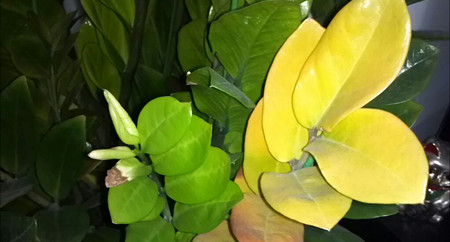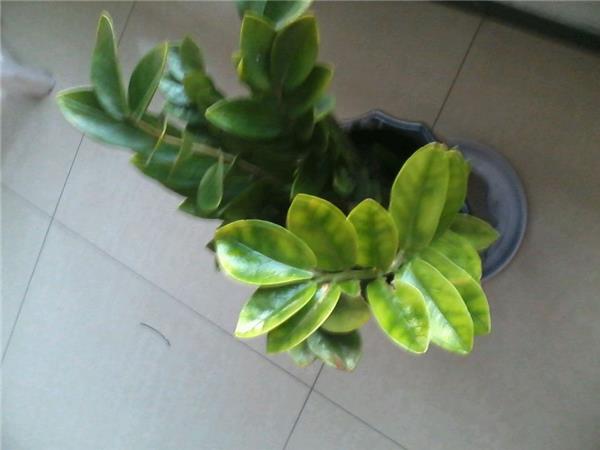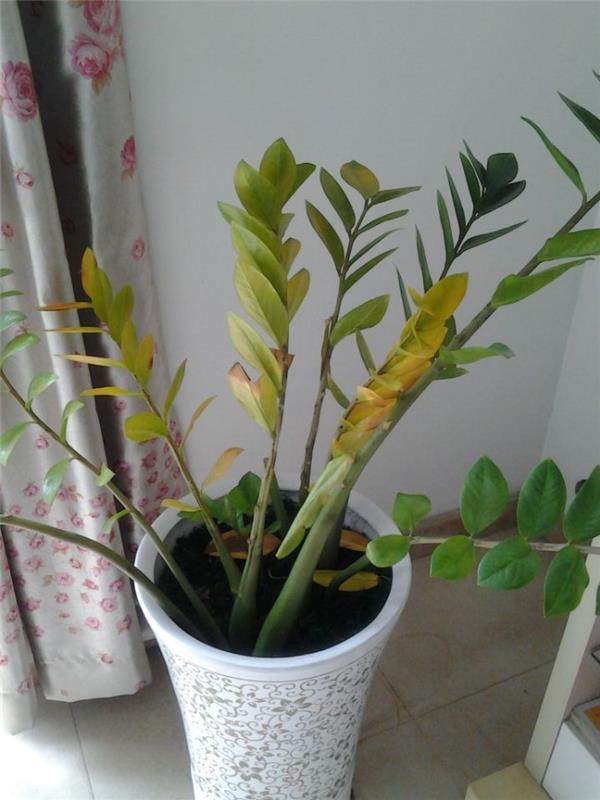[what if the money tree loses its leaves] how to raise the money tree
What if the leaves of the money tree turn yellow and lose their leaves? Friends who cultivate money trees will have a certain understanding of the growth habits of money trees. Money trees are warm and slightly dry, so some friends worry about how to raise money trees in winter. Today, we will tell you some things that we should pay attention to.
What if the leaves of the money tree turn yellow and lose their leaves?
Too much watering
Money tree sex like warm heat, more resistant to drought, but avoid wet water, too much watering will often lead to money tree rotten roots, resulting in yellow leaves. Take the tree out of the basin and check whether the root system is rotten, if it has, replant it with sterilized culture soil, or bury the base of the tree in clean sand, keep it semi-shaded and control watering, but often spray on and around the branches and leaves before regular maintenance can be restored after allowing the tree to reissue new roots. If the root is not rotten, the tree should be half-shaded, because the leaves are few, it is not easy to dry after watering, watering should be controlled, and foliar water is often sprayed to allow the tree to slowly return to normal growth.

The air is too dry
The money tree likes the humid environment, and the suitable air humidity is about 85%. If the leaves are too dry, the leaves will turn yellow. Put the money tree on the wet sand table, usually pay attention to spray some water to the leaves, in order to wash away the fine dust attached to the leaves, and at the same time pay attention to shading. In winter, we should pay attention to spraying water to the leaf surface and the surrounding environment, so that the relative air humidity can reach more than 50%. In addition, in winter, special attention should be paid to the fact that the basin soil should not be too wet, and it is better to be too dry, otherwise, under the condition of low temperature, too wet basin soil is more likely to lead to plant root rot, or even death of the whole plant.
Insufficient acidity of soil
The lack of acidity in the soil can also yellowed the leaves of the tree. The cultivation substrate of Artemisia angustifolia is often mixed with peat, coarse sand or washed cinder and a small amount of garden soil, and its pH value is adjusted to between 6 and 6.5, showing a slightly acidic state. Because of the large stem, well-developed root system and long pinnate compound leaves, it is appropriate to choose a deeper blue-and-white porcelain pot or purple sand pot to plant, but the lower part should be covered with more stones, bricks or bark, and the height is about 1 ~ 4 of the depth of the flowerpot. in order to create a good root environment for air permeability and water filtration.

Improper fertilization
The tree is fond of fertilizer, but it must be well mastered in the process of fertilization. too much or too little fertilization will lead to the yellowing of its leaves. During the growing season, the tree was treated with 0.2% urea and 0.1% potassium dihydrogen phosphate mixture every month. After the Mid-Autumn Festival, in order to enable the tree to survive the winter safely, nitrogen fertilizer should be stopped and 0.3% potassium dihydrogen phosphate solution should be applied continuously for 3 times to promote the hardening and enrichment of the young leaf axis and newly drawn leaves of the tree. When the temperature drops below 15 ℃, all forms of topdressing should be stopped so as not to damage the roots under the condition of low temperature.
Pest attack
Insect pests are also one of the reasons for the yellowing of the leaves of the tree. In the environment of poor ventilation and poor light, the leaves of the tree are easy to be pierced by shell insects. A small amount of family planting and breeding, you can use transparent tape to remove the insect body, you can also use wet cloth to wipe off the live worm body. Productive cultivation, can be in its nymph incubation period, spray 20% of prolactin wettable powder 1000 times solution, insecticidal effect is good.

How to raise the money tree in winter, the precautions are as follows:
I. temperature
It is best to maintain the greenhouse temperature above 10 ℃ in winter. If the room temperature is lower than 5 ℃, it is easy to cause cold damage and seriously endanger the survival of the plant. In late autumn and early winter, when the temperature drops below 8 ℃, it should be transferred to the room with sufficient light, and the temperature should be kept between 8 ℃ and 10 ℃ during the whole overwintering period, which is more safe and reliable.
Second, lighting
Supplementary light should be given to potted plants transferred to the greenhouse in winter. If the water in the basin soil is kept dry, the plant can be kept disease-free for a long time. In addition, the newly extracted pinnate compound leaves do not show obvious phototaxis, and the plant type is good.
Third, moisture
In winter, we should pay special attention to the basin soil should not be too wet, it is better to be too dry, otherwise, under the condition of low temperature, too wet basin soil is more likely to lead to plant root rot, or even death of the whole plant.

IV. Fertilizer
When the temperature drops below 15 ℃, all forms of topdressing should be stopped so as not to damage the roots under the condition of low temperature.
Fifth, prevent cold damage
When the temperature drops below 5 ℃ in winter, coupled with the dampness of the basin soil, it is easy to cause the pinnate tender leaves of the plant to lodge due to cold injury, and when it is serious, it will cause tuber rot, so it is difficult to restore its vitality.
Control methods: whether it is productive cultivation, planned or family cultivation, the temperature of the greenhouse during the overwintering period should be maintained at least 10 ℃, and the basin soil should be kept slightly dry. A small amount of potted plants can be covered with double-layer plastic bags at night on particularly cold days, and then unbagged after the temperature rises the next day.
The insertion of the money tree
Cuttings can use a single leaflet, a leaf axis plus 2 leaves or a single leaf axis. In terms of rooting effect, the cuttings with leaves on the leaf axis had faster rooting speed and higher germination rate, and it was easier to open into larger tubers. After inserting a single leaf into the mixed medium mixed with river sand and vermiculite, a rooting bulb can be formed at the base of the leaf after 10-14 days, and it can grow into a small plant after 2-3 months of cultivation, but the seedling rate is not high in general. If the leaf axis or leaves with leaves are used as cuttings for cuttings, the substrate can be made of general fine sand, or peat soil, perlite and river sand can be mixed at the ratio of 3:1:1 to prepare the substrate. The cuttings are buried at the depth of 1pm, leaving only the leaves outside the substrate, sprayed in a shaded place after spraying water, maintaining the ambient temperature of 25 ℃ ~ 27 ℃, and spraying the leaves once or twice a day depending on the dryness and humidity of the substrate. Keep the substrate slightly moist and must not be too wet, otherwise it will cause cuttings to rot and lead to cuttings failure. When the cuttings form a certain root system, the middle of the root gradually expands to form a spherical tuber, and the tuber increases gradually. some of the young cuttings will wither and die due to high temperature or poor water management, but the tuber can survive. Old mature leaves and cuttings with total petioles can also maintain green and vitality. A small number of tubers can sprout and grow new leaves in the same year, but the growth is weak and slow, and the tubers grow sturdy new buds and grow normally the next year.
Fifth, prevent cold damage
When the temperature drops below 5 ℃ in winter, coupled with the dampness of the basin soil, it is easy to cause the pinnate tender leaves of the plant to lodge due to cold injury, and when it is serious, it will cause tuber rot, so it is difficult to restore its vitality.
Control methods: whether it is productive cultivation, planned or family cultivation, the temperature of the greenhouse during the overwintering period should be maintained at least 10 ℃, and the basin soil should be kept slightly dry. A small amount of potted plants can be covered with double-layer plastic bags at night on particularly cold days, and then unbagged after the temperature rises the next day.
The insertion of the money tree
Cuttings can use a single leaflet, a leaf axis plus 2 leaves or a single leaf axis. In terms of rooting effect, the cuttings with leaves on the leaf axis had faster rooting speed and higher germination rate, and it was easier to open into larger tubers. After inserting a single leaf into the mixed medium mixed with river sand and vermiculite, a rooting bulb can be formed at the base of the leaf after 10-14 days, and it can grow into a small plant after 2-3 months of cultivation, but the seedling rate is not high in general. If the leaf axis or leaves with leaves are used as cuttings for cuttings, the substrate can be made of general fine sand, or peat soil, perlite and river sand can be mixed at the ratio of 3:1:1 to prepare the substrate. The cuttings are buried at the depth of 1pm, leaving only the leaves outside the substrate, sprayed in a shaded place after spraying water, maintaining the ambient temperature of 25 ℃ ~ 27 ℃, and spraying the leaves once or twice a day depending on the dryness and humidity of the substrate. Keep the substrate slightly moist and must not be too wet, otherwise it will cause cuttings to rot and lead to cuttings failure. When the cuttings form a certain root system, the middle of the root gradually expands to form a spherical tuber, and the tuber increases gradually. some of the young cuttings will wither and die due to high temperature or poor water management, but the tuber can survive. Old mature leaves and cuttings with total petioles can also maintain green and vitality. A small number of tubers can sprout and grow new leaves in the same year, but the growth is weak and slow, and the tubers grow sturdy new buds and grow normally the next year.
- Prev

[what if the rainbow jade loses its leaves] how to raise the rainbow jade
[what if the rainbow jade loses its leaves] how to raise the rainbow jade
- Next

[what if the swallow's palm drops the leaf] what if the swallow's palm loses the leaf?
[what if the swallow's palm drops the leaf] what if the swallow's palm loses the leaf?
Related
- Wuhan Hospital Iron Tree Blooming Result Was Instantly Frightened by the Gardener Master
- Which variety of camellia is the most fragrant and best? Which one do you like best?
- What is the small blue coat, the breeding methods and matters needing attention of the succulent plant
- Dormancy time and maintenance management of succulent plants during dormancy
- Minas succulent how to raise, Minas succulent plant pictures
- What are the varieties of winter succulent plants
- How to raise succulent plants in twelve rolls? let's take a look at some experience of breeding twelve rolls.
- Attention should be paid to water control for succulent plants during dormant period (winter and summer)
- Watering experience of twelve rolls of succulent plants
- Techniques for fertilizing succulent plants. An article will let you know how to fertilize succulent plants.

